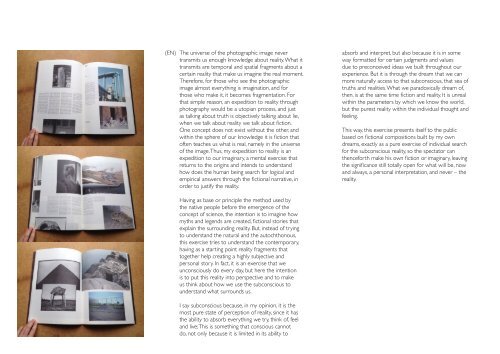PORTFÓLIO TIAGO CASANOVA
Create successful ePaper yourself
Turn your PDF publications into a flip-book with our unique Google optimized e-Paper software.
(EN)<br />
The universe of the photographic image never<br />
transmits us enough knowledge about reality. What it<br />
transmits are temporal and spatial fragments about a<br />
certain reality that make us imagine the real moment.<br />
Therefore, for those who see the photographic<br />
image almost everything is imagination, and for<br />
those who make it, it becomes fragmentation. For<br />
that simple reason, an expedition to reality through<br />
photography would be a utopian process, and just<br />
as talking about truth is objectively talking about lie,<br />
when we talk about reality we talk about fiction.<br />
One concept does not exist without the other, and<br />
within the sphere of our knowledge it is fiction that<br />
often teaches us what is real, namely in the universe<br />
of the image. Thus, my expedition to reality is an<br />
expedition to our imaginary, a mental exercise that<br />
returns to the origins and intends to understand<br />
how does the human being search for logical and<br />
empirical answers through the fictional narrative, in<br />
order to justify the reality.<br />
absorb and interpret, but also because it is in some<br />
way formatted for certain judgments and values<br />
due to preconceived ideas we built throughout our<br />
experience. But it is through the dream that we can<br />
more naturally access to that subconscious, that sea of<br />
truths and realities. What we paradoxically dream of,<br />
then, is at the same time fiction and reality. It is unreal<br />
within the parameters by which we know the world,<br />
but the purest reality within the individual thought and<br />
feeling.<br />
This way, this exercise presents itself to the public<br />
based on fictional compositions built by my own<br />
dreams, exactly as a pure exercise of individual search<br />
for the subconscious reality, so the spectator can<br />
thenceforth make his own fiction or imaginary, leaving<br />
the significance still totally open for what will be, now<br />
and always, a personal interpretation, and never – the<br />
reality.<br />
Having as base or principle the method used by<br />
the native people before the emergence of the<br />
concept of science, the intention is to imagine how<br />
myths and legends are created, fictional stories that<br />
explain the surrounding reality. But, instead of trying<br />
to understand the natural and the autochthonous,<br />
this exercise tries to understand the contemporary,<br />
having as a starting point reality fragments that<br />
together help creating a highly subjective and<br />
personal story. In fact, it is an exercise that we<br />
unconsciously do every day, but here the intention<br />
is to put this reality into perspective and to make<br />
us think about how we use the subconscious to<br />
understand what surrounds us.<br />
I say subconscious because, in my opinion, it is the<br />
most pure state of perception of reality, since it has<br />
the ability to absorb everything we try, think of, feel<br />
and live; This is something that conscious cannot<br />
do, not only because it is limited in its ability to


















